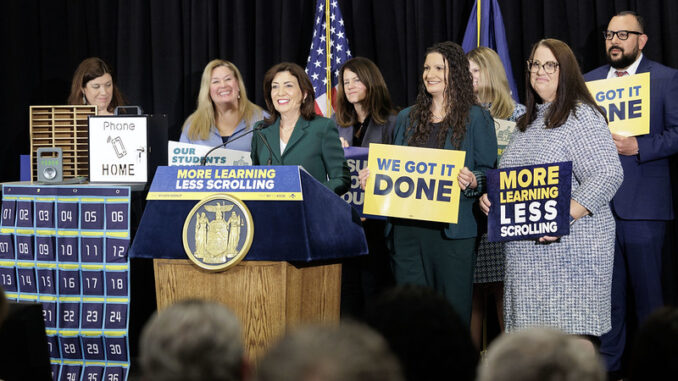
Governor Kathy Hochul held a press conference in Albany on May 6 to announce that New York is becoming the largest state in the nation to require statewide, bell-to-bell restrictions on smartphones in K-12 schools.
She was able to secure this new edict as part of the agreement on the FY 2026 state budget. Once the budget is officially approved, New York State’s distraction-free schools policy will take effect this fall for the 2025-2026 school year. The restrictions apply to all public schools, as well as charter schools and BOCES (Board of Cooperative Education Services).
“New York was the first state to target addictive social media feeds — and now we’re the largest state to restrict smartphones in schools throughout the entire school day,” Hochul said. “I know our young people succeed when they’re learning and growing, not clicking and scrolling — and that’s why New York continues to lead the nation on protecting our kids in the digital age.”
Hochul’s cellphone policy creates a statewide standard for distraction-free schools in New York including:
- No unsanctioned use of smartphones and other Internet-enabled personal devices on school grounds in K-12 schools for the entire school day (from “bell to bell”), including classroom time and other settings like lunch and study hall periods.
- Allows schools to develop their own plans for storing smartphones during the day — giving administrators and teachers the flexibility to do what works best for their buildings and students.
- Secures $13.5 million in funding to be made available for schools that need assistance in purchasing storage solutions to help them go distraction-free.
- Requires schools to give parents a way to contact their kids during the day when necessary.
- Requires teachers, parents and students to be consulted in developing the local policy.
- Prevents inequitable discipline.
However, the policy clarifies that students would still be authorized to have access to simple cellphones without Internet capability, as well as internet-enabled devices officially provided by their school for classroom instruction, such as laptops or tablets used as part of lesson plans.
Additionally, the governor’s policy includes several exemptions to smartphone restrictions, including for students who require access to an Internet-enabled device to manage a medical condition, where required by a student’s Individualized Education Program (IEP), for academic purposes, or for other legitimate purposes, such as translation, family caregiving and emergencies.
Hochul pursued this initiative after engaging in a statewide listening tour with teachers, parents, and students, and gathering findings to support the need for greater cellphone restriction in our schools. Her report “More Learning, Less Scrolling: Creating Distraction-Free Schools” includes:
- Smartphones distract students and inhibit learning and creativity.
- Phone-free environments do not compromise student safety.
- Phone-free environments support the mental health of students and teachers.
- Open communication and direct guidance for all stakeholders is key for successful implementation.
- Schools must address any parent concerns about staying in contact with their children during the day.
- An effective distraction-free policy must focus on the entire school day, rather than solely on time in the classroom.
- Schools can strengthen their distraction-free environment by connecting more students with in-person engagement like clubs, sports, arts and other programming.
New York State United Teachers President Melinda Person, president of the New York State United Teachers, said the restrictions on cellphone use “isn’t about being anti-phone or anti-technology — it’s about being pro-childhood.”
“We’re giving students seven hours a day free from distractions so they can focus on learning, access their creativity, and make real human connections,” Person said. “Tackling social media and technology use as a public health issue will take continued partnership, education, and courage — and New York is ready to lead the way.”
New York State Congress of Parents and Teachers Executive Director Kyle Belokopitsky said, “The classroom, lunchroom, and school hallways should be spaces to learn, to connect, to engage, and to communicate — and we are excited to bring meaningful change to our schools and children. We know this work might be hard, and might be challenging in the beginning, but we owe this support to our children, to their futures, and to their mental health and wellbeing.”
Phones Free New York Founder Raj Goyle said, “As a New York Dad of two teenage girls, I am proud that New York will be the largest state in the country with a bell-to-bell ban. … It’s a new day for our kids and teachers alike.”
Mothers Against Media Addiction Founder and Executive Director Julie Scelfo said, “Smartphones are designed to be addictive in a way that makes it harder for kids to focus and learn,” added Julie Scelfo, founder and executive director of Mothers Against Media Addiction.
Mothers Against Media Addiction’s Harlem Chapter Leader and Child Welfare Attorney Muna Heaven said, “Parents and educators are frustrated by what these addictive technologies are doing to our children, and I am so proud to live in a state where our policymakers are actually listening and willing to fight for what they know is right. Thanks to our advocacy and to leaders like Governor Hochul, New York is now the largest state in the country to pass full bell-to-bell smartphone restrictions for all K-12 schools, a policy that will not only improve educational outcomes, but also the overall well-being of students statewide.”

